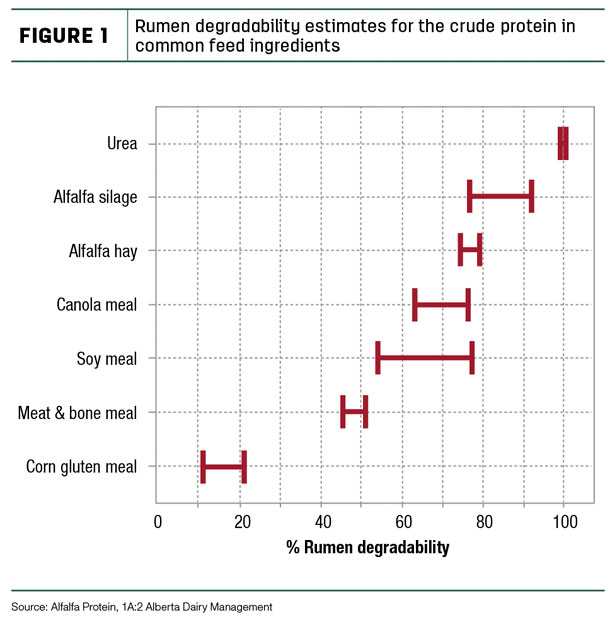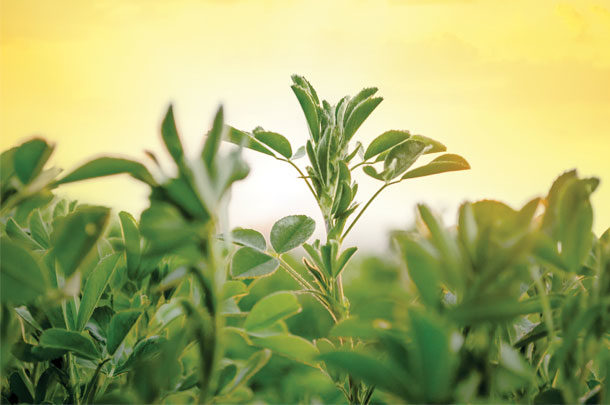Alfalfa has long been appreciated for its high protein content. It is normally around 20% crude protein (CP) for dairy-quality hay/haylage and 16% to 18% CP when harvested at first flower to mid-flower for growing animals. Both are at or above the 14% to 16% protein needs of animals. The value of this protein has increased as more low-protein feeds (such as corn silage) are being fed in rations.
Most of the alfalfa protein is in leaves, which usually contain about 25% to 30% CP while the stem contains 6% to 10% CP. Thus, tall or stemmy alfalfa tends to be lower in whole-plant CP than shorter alfalfa.
The best way to have high-protein alfalfa is to cut it early and minimize leaf loss during harvest.
However, there are some special considerations about alfalfa protein. About 50% of the leaf protein is ribulose-1,5-bisphosphate carboxylase-oxygenase, an enzyme which catalyzes the first step of using carbon dioxide to produce sugars in the plant. This enzyme and most other leaf proteins are water-soluble which allows rumen microbes to quickly access and to break down much of the alfalfa protein to make microbial protein.
Microbial protein contains less sulfur-containing amino acids than the cow needs. Thus, even if the plant protein had a good level of these amino acids, they would be lost to the animal if the protein was degraded (metabolized by microbes) in the rumen. Further, excessive degradation of forage proteins in the rumen leads to ammonia-N (NH3-N) production. When NH3-N exceeds microbial requirement, it is absorbed from the rumen and converted to urea in the liver. Conversion of NH3-N to urea in the liver requires energy. Thus, urea excretion in urine is both a metabolic burden to the animal and an economic loss to the farmer, since nitrogen is the most expensive component of animal diets. Approximately 75% to 85% of the nitrogen consumed by livestock is excreted.
Alfalfa protein is more highly degradable (Figure 1) than many other sources of protein, which allows more protein to bypass the rumen and be degraded in the intestine where the amino acids can be absorbed directly by the animal.

This is the only way to get more sulfur-containing amino acids to the cow.
As Figure 1 also shows, alfalfa hay protein is less degradable in the rumen than alfalfa silage protein. When forages are ensiled, bacteria ferment the forage, producing acids and breaking down some of the forage protein into peptides through the activity of protease enzymes; the peptides are subsequently degraded by rumen bacteria. In one study, when compared to fresh forage, the nonprotein nitrogen (NPN) content of ensiled forage increased by 66% while the increase in hay was 25%.
When forage is ensiled too dry, oxygen elimination is not satisfactory (poor packing) or both, excessive heat can be produced during the fermentation process. Similarly, hay baled too wet will heat. Heating may reduce the breakdown of alfalfa protein in hay and silage. Heating enhances the Maillard reaction where sugars are linked to proteins by a bond between amino acids (mostly lysine and arginine) and reducing sugars. The Maillard reaction makes forage (and human food) smell and taste better. However, the reaction reduces the ability of normal rumen proteases to break down proteins. However, too much Maillard reaction may not allow the proteins to be degraded in the intestine. A little browning may be good, but too much may reduce protein solubility and digestibility in both the rumen and intestine so that protein is totally unavailable and passes out of the cow in feces.
Management for best protein value
Reduced rumen degradability of dietary proteins is desired because:
- Protein requirements of high-producing animals cannot be met from rumen microbial sources.
- Protein is the most expensive component of ruminant animal diets.
- Excessive rumen degradation of proteins leads to greater amounts of nitrogenous compounds excreted in the urine and feces, which is a major environmental concern.
- High plasma urea associated with extensive protein degradation in the rumen can cause reproductive problems in dairy cows.
- Rapid and excessive ruminal degradation of fresh alfalfa protein can cause bloat, which in severe cases causes death of the animal.
While nitrogen fertilizers (or manure applications) can increase the apparent CP of forage, the increased CP is not protein, but nitrate, nitrite or free amino acids. This “protein” is not actually well utilized by ruminants on high-performance diets since it immediately releases into the rumen upon ingestion to form ammonia.
The best way to improve total CP is to cut early, choose a more dormant variety (but give up yield) and manage the harvest to retain the leaf fraction. However, if cut too early, protein degradability will be elevated. With advancing plant maturity, true plant protein synthesis increases and the cell wall becomes more lignified, rendering alfalfa protein less accessible to rumen bacteria and therefore less degradable.
Seeing the effect of Maillard on protein digestibility, some have considered heat treatment of forage to reduce bypass protein. In one study, heating alfalfa (100°C for two minutes) before ensiling reduced protease activity in forage sample by 34% and increased total amino acid reaching small intestine by 42%. However, such heating may reduce the feeding value through oxidation of carbohydrates, dry matter loss and mold growth.
Another approach has been to add tannins to forage when ensiling. Tannins are naturally occurring polyphenolic compounds of high molecular weight that bind to proteins. They are known to increase bypass protein in birdsfoot trefoil and sainfoin. Tannins form complexes with proteins at a pH range of 3 to 7. They reduce the bloat potential for fresh forage. However, tannins can reduce organic matter digestibility and be sufficiently unpalatable to reduce voluntary intake. In one study, the addition of tannin reduced ruminal CP disappearance in proportion to the amount of tannin added. The tannin reduced organic matter digestibility by 5.1% for all of the tannin addition levels. However, tannin has been shown to improve silage quality in the round bale silages, particularly reducing ammonia and nonprotein nitrogen.
In general, treatments of alfalfa hay and silage have not proven cost-effective for reducing ruminal degradation of alfalfa protein, especially when considering the associated loss of palatability (feed intake) and organic matter digestibility.
However, adding inoculant (Lactobacillus planetarium) when ensiling can jump-start fermentation and direct fermentation so that degradation of protein in the silo is reduced.
One can maximize the protein in alfalfa by minimizing leaf loss during growth by growing disease-resistant plants and, in some cases, using a fungicide, and then to manage harvest carefully to minimize leaf loss.
When attempting to maximize benefit of the protein in alfalfa in diets, first consider that the protein level in first- to mid-flower alfalfa is adequate to meet the dietary needs of most growing animals.
The greatest management challenge comes when feeding dairy cattle which have the highest energy, protein and amino acid needs. First, manage rations so that energy and protein release in rumen are synchronized to enhance the incorporation of feed nitrogen by ruminal microbes into microbial protein. Second, know the level of rumen-degradable protein in the diet and feed a source of bypass protein to increase protein passage to the small intestine.
Breeding for the future
Biotechnology has opened many new opportunities for producing crops of increased value at reduced cost. A number of approaches are attempting to reduce the degradable protein of alfalfa.
Tannins in other forages bind with protein in the rumen and reduce rumen protein degradability. Alfalfa naturally produces tannins in the seed coat but only at very low levels in the rest of the plant. This means the genes are present in the plant for tannin production but not turned on in the leaves and stems. One effort has been to attempt to modify the alfalfa genes so that the tannin-production genes are turned on in the leaves. Elevated tannin levels have additionally been shown to reduce bloat potential of birdsfoot trefoil and sainfoin.
Another effort has been to attempt to move genes from red clover to alfalfa. Red clover contains polyphenol oxidase enzymes that inhibit protein breakdown. (This is the same enzyme that causes sliced apples to turn brown when exposed to air.) Since silage fermentation does not break down red clover protein to the same extent as alfalfa, red clover has more undegradable protein. Bypass protein of red clover haylage is 25% to 35% of total protein, while alfalfa is 15% to 25%. Red clover generally has fiber digestibility equal to or greater than alfalfa.
A third approach is to move tannin-production genes from other legumes to alfalfa. This has been done, but the tricky part is to get the right amount of tannin production. A little is good (reduced rumen degradation of protein), but too much will cause the forage to be less digestible and less palatable, reducing forage intake. This was shown by the development of bird-resistant sorghum to minimize bird damage to the grain at the top of the plant in the 1980s. Tannin-producing genes were incorporated into the sorghum from wild types. The first-generation material did reduce bird feeding but had such high tannin levels that cattle wouldn’t eat it either. So a second round of material was developed that had less tannin, sufficient for bird resistance and low enough not to reduce cattle consumption.
Alfalfa is already a valuable forage for animals with its high protein, low cell wall and high energy content; with the continued effort to improve it, the future looks bright.









